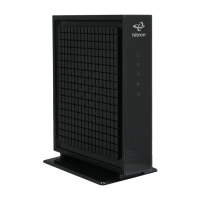Version 1.1, 08/2013. Copyright 2012 Hitron Technologies
38
Version 1.1, 08/2013. Copyright 2013 Hitron Technologies
38
Hitron CGN3 User’s Guide
3.1.6 Routing Mode
When your CGN3 is in routing mode, it acts as a gateway for computers on the LAN
to access the Internet. The service provider assigns an IP address to the CGN3 on
the WAN, and all traffic for LAN computers is sent to that IP address. The CGN3
assigns private IP addresses to LAN computers (when DHCP is active), and
transmits the relevant traffic to each private IP address.
NOTE: When DHCP is not active on the CGN3 in routing mode, each computer on
the LAN must be assigned an IP address in the CGN3’s subnet manually.
When the CGN3 is not in routing mode, the service provider assigns an IP address to
each computer connected to the CGN3 directly. The CGN3 does not perform any
routing operations, and traffic flows between the computers and the service provider.
Routing mode is not user-configurable; it is specified by the service provider in the
CGN3’s configuration file.
3.1.7 Configuration Files
The CGN3’s configuration (or config) file is a document that the CGN3 obtains
automatically over the Internet from the service provider’s server, which specifies the
settings that the CGN3 should use. It contains a variety of settings that are not
present in the user-configurable Graphical User Interface (GUI) and can be specified
only by the service provider.
3.1.8 Downstream and Upstream Transmissions
The terms “downstream” and “upstream” refer to data traffic flows, and indicate the
direction in which the traffic is traveling. “Downstream” refers to traffic from the
service provider to the CGN3, and “upstream” refers to traffic from the CGN3 to the
service provider.
3.1.9 Cable Frequencies
Just like radio transmissions, data transmissions over the cable network must exist
on different frequencies in order to avoid interference between signals.
The data traffic band is separate from the TV band, and each data channel is
separate from other data channels.

